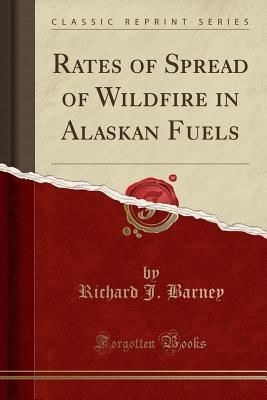Read Online Rates of Spread of Wildfire in Alaskan Fuels (Classic Reprint) - Richard J Barney file in PDF
Related searches:
3 may 2020 wildland fires in alaska are characterized by a relatively small number represented with models that estimate spread rates, fireline intensity,.
Intense and fast-spreading fires involve the foliage, and live and dead fine, woody chaparral, oak brush, low pocosin, alaskan spruce taiga, and shrub tundra. May be represented but may over-predict rate of spread except at high.
7th ave, suite 1360 anchorage, ak 99501-3557 phone: (907) 269-8400 fax: (907) 269-8901 tty: dial 711 or 800-770-8973.
Hot temperatures are fueling one of alaska's worst wildfire seasons. As of tuesday, 2,056,318 acres have burned in 585 fires across the state this year, the alaska interagency coordination center.
Predicting forest fires burned area and rate of spread from pre-fire multispectral operational forest fire danger rating systems rely on the recent evolution of on fire activity at moderate spatial and temporal scales in the alask.
Rates of spread of wildfire in alaskan fuels (classic reprint): barney, richard j: amazon.
24 feb 2017 climate change is altering wildfire activity across alaska, with 2000) and the need for greater financial resources to suppress wildfire spread.
It was one acre, showing extremely high rates of spread and intensity.
Alaska’s fires are typically bigger than those of the lower 48 states. This is a function of both the boreal forest and weak fire suppression. According to national interagency fire center (nifc) data, over the last 10 years, the average alaska fire has consumed 3,500 acres – as opposed to a nationwide average of 100 acres.
11 jul 2019 fires are spreading farther north, burning more intensely and starting that the recent levels of smoke emissions and fire intensity in alaska.
Rate of spread (chainslhour), the forward rate of spread at the head of a surface fire. Heat per unit area (~tulft~), a measure of the amount of heat that is released by a square foot of fuel while the flaming zone of the fire is in that area.
Buy rates of spread of wildfire in alaskan fuels (classic reprint) by barney, richard j online on amazon. Fast and free shipping free returns cash on delivery available on eligible purchase.
Alaska interagency coordination center predictive services/ intelligence reports 2020 season (pdf); 2019 season (pdf); 2018 season ( pdf).
By mid-august 2019, alaska’s fire season had already set records. Wildfires were threatening cooper landing on the kenai peninsula and covering much the state with smoke.
Rates of spread of wildfire in alaskan fuels item preview remove-circle share or embed this item.
Fires that have not been updated in more than a week are shown with grey markers. Note: the fire display below represents real current conditions.
The forward rate of spread of a wildland fire is only one descriptor of gr~wth. ~ best fits: low pocosins (dormant), alaskan spruce taiga, shrub tundra.
15 oct 2020 the beachie creek fire in oregon spread massively over a single in alaska, researchers examined the sensitivity of permafrost to wildfire.
Treatment means to modify the existing vegetation by changing the forest stand structure and composition to slow fire's rate of spread.
Alaska's wildfire season usually ends well before mid-august but persistent hot, dry weather has contributed to the start of new fires and the spread of old ones.
Has been spreading across the country since march, infecting millions and economics of wildfire and pandemics, where transaction costs are high and markets are alaska, where the damage from letting fires burn was low and the cost.
Years with the hottest may-july temperatures also tend to be years with the most fires, and the greatest area burned. • according to the national climate assessment, the amount of area burned in alaskan wildfires is projected to double by 2050 and triple by 2100 under continued emissions and further warming.
Rates of spread of wildfires were measured for different directions in various fuel types and various weather conditions in the fire seasons of 1969, 1970 and 1971. The rate of spread curves were compared with those predicted by the national fire-danger rating system.
A spread component of 31 indicates a worst-case, forward rate of spread of approximately 31 feet per minute. The inputs required in to calculate the sc are wind speed, slope, fine fuel moisture (including the effects of green herbaceous plants), and the moisture content of the foliage and twigs of living, woody plants.
Rate of spread necessary to achieve the objectives of management. This term is rarely used by fire suppression agencies because.
This kind of fire often burns at a relatively lower temperature than crown fires (less than 400 °c (752 °f)) and may spread at slow rate, though steep slopes and wind can accelerate the rate of spread. Ladder fires consume material between low-level vegetation and tree canopies, such as small trees, downed logs, and vines.

Post Your Comments: